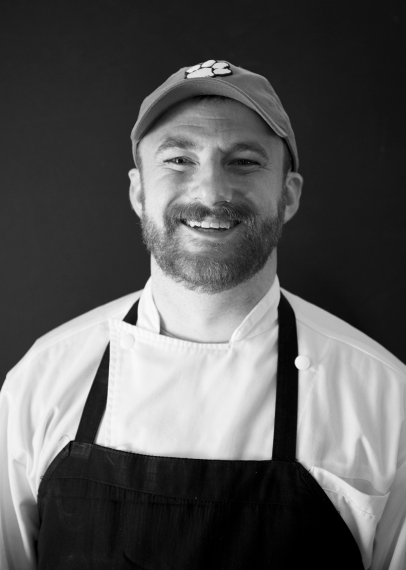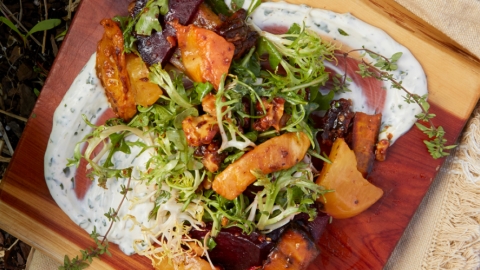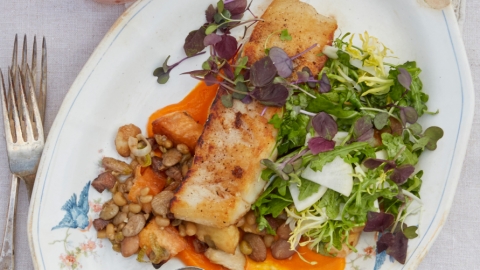Southern Born and Bred: Chef Trevor Smith
Sourcing Seasonal and Local is Chef Smiths' Culture
To Trevor Smith, eating food made from local, homegrown ingredients is what comes naturally. "That's just how things should be," Smith says, donning a Clemson Orange ball cap.
Smith is the executive chef of Harold’s Cabin, a neighborhood restaurant, corner store and café in the Westside of Charleston.
“We have this bounty growing and that’s what Charleston was founded on. Growing food is part of the culture here, and it is part of my culture.”
Harold’s Cabin is Smith’s first executive chef role. He grew up in the Georgia mountain town of Clarkesville, but his grandparents owned a small cow farm in Saluda, South Carolina, where they grew a produce garden for each season. Smith remembers that a lot of the food he ate throughout his childhood came from their land and the land of surrounding farmers, rather than from a grocery store—in fact, he didn’t eat store-bought beef at home until he was 19, and the family didn’t go to the store for simple things like jelly.
“It was, ‘look in the antique jelly cupboard’ and see what we made that we wanted to open,” Smith says. “We had a huge blueberry plant that a neighbor planted and let do its thing, and we would pick blueberries and go foraging for blackberries and muscadines and scuppernongs.”
Smith was first introduced to the kitchen in the way that many people who live in big, working families are. As the oldest of five children, with three boys, he would often help his mother prepare meals for their family.
“When it came time for the grandmothers to impart family recipes and teach someone how to cook, I was it by default,” Smith says. “I was always in the kitchen helping out with family dinners and Christmas and Thanksgiving.”
After graduating high school, Smith started a job at the country club in his hometown with some of his friends.
“I figured it would be a stereotypical, ‘kids just graduated high school, all working at the country club’ trying to recreate Caddyshack, and then [I] kind of fell in love with it.”
His restaurant experience started with dishwashing, but with his experience cooking for his family, Smith quickly gravitated towards the cooking.
“I was that dishwasher who was always bothering the chef,” Smith says with a laugh. “‘I can cut onions, I can cut potatoes’—I knew how to do small stuff like that.” Smith started picking up more kitchen shifts, and then moved on to working the fryer and food prepping. While it was a large club, it was a small clubhouse; every day he got one-on-one instruction with the chef, and he began displaying an aptitude in the art of cooking.
“It was a decision time; do I continue going to college, where it’s more or less the same reading, writing and arithmetic, or actually enjoy being at work and learn to cook, which I enjoyed more than the academic side.” Inevitably, Smith decided to attend the New England Culinary Institute in Montpelier, Vermont, and received his culinary education in the birthplace of the farm-to-table movement as it was beginning to take shape, and this focus on local ingredients and farmers both complemented and reinforced his childhood experience.
Smith was first introduced to the idea of living in the Lowcountry while working in a Vermont ski resort whose parent company owns Wild Dunes Resort on Isle of Palms. He did some research on the growing culinary scene in Charleston, which in 2010 had just begun, and fell in love with the area. Smith especially liked that local farmers had a strong presence in Charleston-area restaurants, and after becoming executive chef of Harold’s Cabin, he wanted to showcase this. Roughly 90% of the produce that Harold’s Cabin uses is local to South Carolina, and about 75% is local to Charleston.
“A lot of people say, ‘that’s really cool that you’re doing that,’ and I have the mentality that’s just what I should be doing. It’s not hard—I don’t need cantaloupe on my menu in January. I can wait,” Smith says, explaining that when you eat locally and seasonally, the ingredients taste better and are more versatile.
Some of his favorite local foods include fish, okra and Geechie Boy grits. And now that spring is back in the Lowcountry, Smith is excited to once again cook with radishes, tomatoes, sugar peas and flowering grains like amaranth, which he describes as a fuzzy octopus hanging in the back of the rooftop garden of Harold’s Cabin.
Smith enjoys stepping out from behind the fire to talk with his guests and about the fresh ingredients and his meals that showcase them. He creates a learning environment where he hopes patrons and staff can really understand the importance of respecting local areas and using local ingredients; with his menu at Harold’s Cabin, Smith shows that cooking with fresh, local ingredients is not only simple, but ultimately more flavorful and gratifying, even in something as simple as a peanut butter and jelly sandwich.
“Even if you get store-bought peanut butter, nothing special—but if you top it with a jelly that you made, and have that one component that’s all yours, it makes it into something that no one else is going to get. That’s your peanut butter and jelly sandwich. You made the jelly, you spent the time; that’s your creation.”








